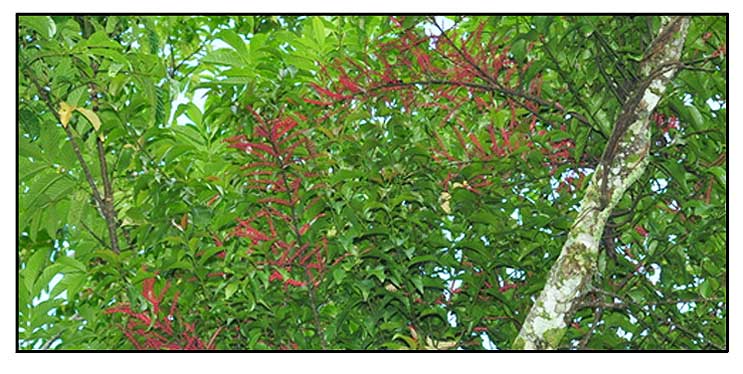
Family • Loranthaceae
Red-spike mistletoe
Helixanthera parasitica Lour.
MISTLETOE TREE / BROAD-LEAVED CHERRY TREE
| Scientific names | Common names |
| Helicia parasitica Pers. | Broad-leaved cherry tree (Engl.) |
| Helixanthera annamica Danser | Mistletoe tree (Engl.) |
| Helixanthera parasitica Lour. | Red-spike mistletoe (Engl.) |
| Helixanthera parviflora Danser | |
| Helixanthera sumatrana Danser | |
| Helixanthera xestophylla (Miq.) Danser | |
| Lanthorus blumeanus Tiegh. | |
| Lanthorus cumingii Tiegh. | |
| Lanthorus macrostachys Tiegh. | |
| Lanthorus pentasepalus Tiegh. | |
| Lanthorus spicifer C.Presl | |
| Leucobotrys adpressa Tiegh. | |
| Loranthus adpressus (Tiegh.) Engl. | |
| Loranthus blumeanus (Tiegh.) Engl. | |
| Loranthus cumingii (Tiegh.) Engl. | |
| Loranthus macrostachys Korth. | |
| Loranthus spicifer (C.Presl) Fern.-Vill. | |
| Loranthus xestophyllus (Miq.) Merr. | |
| Phyoenicanthemum xestophyllum Miq. | |
| Hekixanthera parasitica is an accepted species. KEW: Plants of the World Online | |
| Other vernacular names |
| INDIA: Tasik |
| INDONESIA: Cendena semut (Javanese), Kamoneng alas (Kangean), Blaping (Timor). |
| THAILAND: Kafak ko (Norther), Toe-si-na-doe (Karen Mae Hong Son), Kafak mai mangtan (Chumphon). |
• Glabrous except for the inflorescence and flowers hairy when young, soon glabrescent except sometimes for the inflorescence axis and fruit remaining shortly pale brown-tomentose and the ovary remaining grey-white tomentose. Leaves opposite or subopposite; lamina ovate, 5–18 by 1.5–6(–8) cm, cuneate to truncate at the base to a petiole 5–20 mm long, acuminate and acute at the apex, thin, lustrous or dull on either side; venation pinnate with the midrib and main laterals distinct on both sides. Inflorescences at the nodes, a many-flowered raceme; axis (50–)100–300 mm long; pedicels (0.3–)1–2 mm long, often verticillately clustered; bracts ovate or triangular, sometimes with a dorsal transverse fold, obtuse or acute, 0.7–1.5 mm long. Ovary campanulate, 1, 5–3 mm long; calyx limb entire, spreading, 0.3–0.7 mm long. Corolla in mature bud 5–merous, (3–)4–9 mm long, usually strongly keeled in the lower part, narrowed to a slender neck, clavate and obtuse or rounded at the apex, mostly bright red, rarely almost white. Anther 1–2.5 mm long, obtuse, about equal to the free part of the filament. Style (2–)3–5(–6) mm long, reaching to the base of the anthers, angular in the lower 1–3 mm below a distinct constriction, more slender above; stigma capitate, hardly wider than the style apex. Distribution
Properties Availability |
November 2025
![]()
 |
| PHOTOS / ILLUSTRATIONS |
| IMAGE SOURCE: Helixanthera parasitica - Flower close-up/ © Agnes Trekker / CC0 / Public Domain / Image modified / Click on image or link to go to source page / iNaturalist |
| OTHER IMAGE SOURCE: Helixanthera parasitica - Growing on a tree / © Cheongweei Gan / CC BY 4,0 International / Some rights reserved / Click on image or link to go to source page / iNaturalist |
| OTHER IMAGE SOURCE: Helixanthera parasitica - Flower / © Forest Herbarium / Non-commercial use / Image modified / Click on image or link to go to source page / Forest Herbarium |
| OTHER IMAGE SOURCE: Helixanthera parasitica - Leaf / © Forest Herbarium / Non-commercial use / Image modified / Click on image or link to go to source page / Forest Herbarium |
Additional
Sources and Suggested Readings |
• |
DOI: It is not uncommon for links on studies/sources to change. Copying and pasting the information on the search window or using the DOI (if available) will often redirect to the new link page. (Citing and Using a (DOI) Digital Object Identifier) |
| List of Understudied Philippine Medicinal Plants |
| New plant names needed The compilation now numbers over 1,730 medicinal plants. While I believe there are hundreds more that can be added to the collection, they are becoming more difficult to find. If you have a plant to suggest for inclusion, native or introduced, please email the info: scientific name (most helpful), local plant name (if known), any known folkloric medicinal use, and, if possible, a photo. Your help will be greatly appreciated. |
• |
 |

 Gen info
Gen info Botany
Botany
